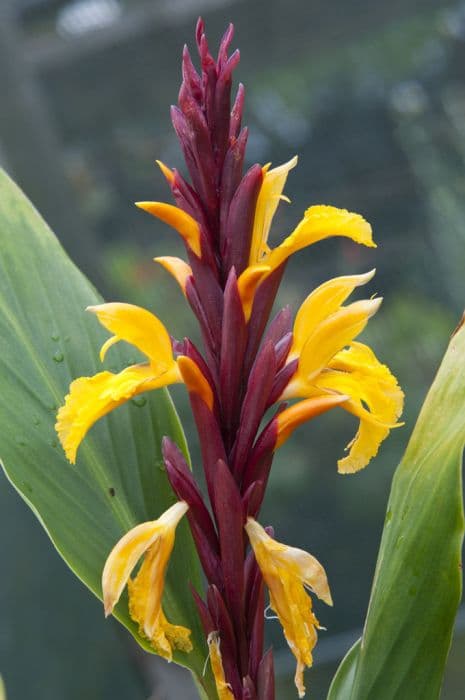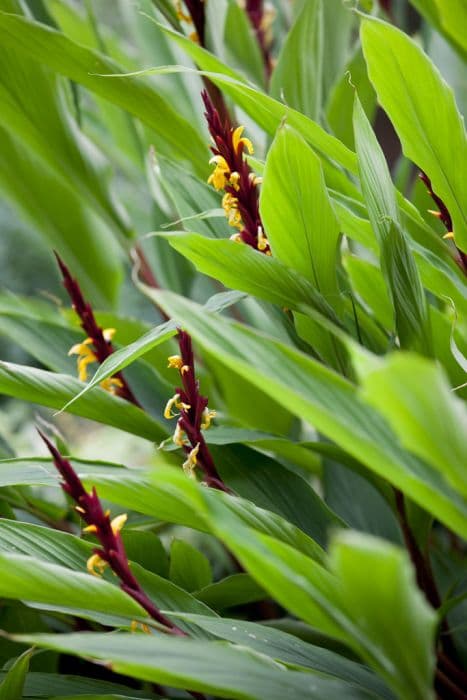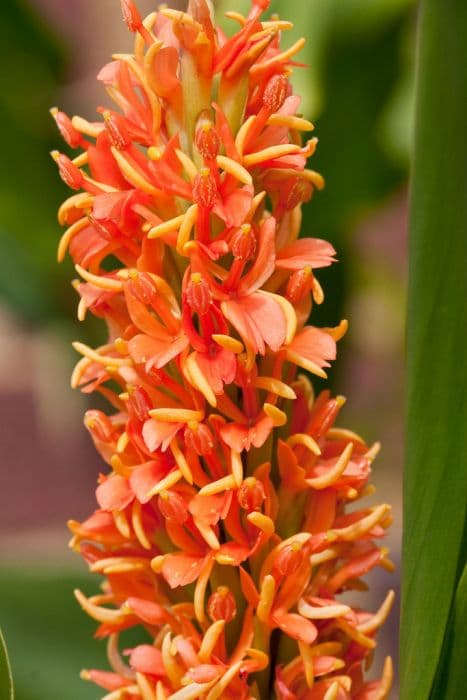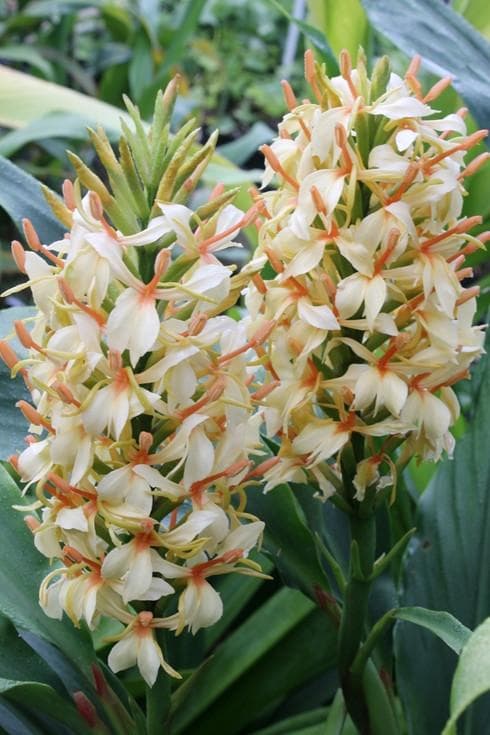Cardamom Elettaria cardamomum

ABOUT
Elettaria cardamomum, commonly known as cardamom, is a perennial plant characterized by long, thin, and erect green shoots. The leaves are large, lance-shaped, and a deep green color, with a smooth and glossy texture. The foliage often exudes a pleasant, spicy fragrance when rubbed or crushed. Cardamom plants produce small and grouped flowers that are usually a pale green to yellowish color, often with a hint of purple or white. The flowers are intricate and tubular, attracting pollinators to the garden. These blooms eventually give way to the treasured spice: the cardamom pods. The pods are small, oval-shaped, and green when immature, turning to a yellowish or even slightly brownish color as they mature and dry. These seed pods are known for housing the precious cardamom seeds, which are small, black, and sticky if fresh. The appearance of the seeds is rather granular and irregular, and they are the main reason for this plant's cultivation, as they are sought after for culinary and aromatic purposes.
About this plant
 Names
NamesSynonyms
Cardamom, Green Cardamom, True Cardamom, Small Cardamom.
Common names
Amomum cardamomum, Amomum ensal, Amomum repens, Alpinia cardamomum, Cardamomum malabaricum, Cardamomum minus, Elettaria cardamoma, Matonia cardamomum, Zingiber cardamomum.
 Toxicity
ToxicityTo humans
Cardamom is generally considered non-toxic to humans. It is widely used as a spice and flavoring agent in cooking and baking and in traditional medicine. There are no well-known toxic effects from ingesting cardamom in typical culinary quantities. However, consuming cardamom in very large quantities may lead to gastrointestinal upset or allergic reactions in some individuals. Those with gallstone issues should also use it cautiously as it may trigger gallstone colic. As with any substance, if an uncommon allergic reaction occurs, symptoms might include skin rashes, respiratory issues, or anaphylaxis in very rare cases.
To pets
Cardamom is not toxic to pets. It is safe for cats and dogs in small quantities typically used in cooking. However, as with any non-typical food, it can cause gastrointestinal upset if consumed in large amounts or if the pet has a sensitive stomach. Pets with certain health conditions may react differently, so it's always best to consult with a veterinarian before introducing significant amounts of any new food into a pet's diet. In general, though, cardamom is not a concern as a toxin for pets.
 Characteristics
CharacteristicsLife cycle
Perennials
Foliage type
Evergreen
Color of leaves
Green
Flower color
White
Height
6-10 feet (1.8-3 meters)
Spread
2-4 feet (0.6-1.2 meters)
Plant type
Herb
Hardiness zones
10
Native area
India
Benefits
 General Benefits
General Benefits- Culinary Uses - Elettaria cardamomum, commonly known as cardamom, is widely used in cooking for its unique flavor and aroma, enhancing the taste of both sweet and savory dishes.
- Aromatic Agent - Cardamom's distinct fragrance is employed in perfumery, imparting its scent to various personal care products like soaps and lotions.
- Insect Repellent - The strong scent of cardamom can act as a natural insect deterrent, keeping pests away from stored foods and living spaces.
- Cultural Significance - In many cultures, cardamom is used in rituals and celebrations, imbuing events with its characteristic aroma and symbolism of hospitality.
- Antioxidant Properties - While not a medical effect, cardamom contains antioxidants which are generally considered beneficial for maintaining overall health.
- Flavor Preservation - Cardamom pods can be stored for extended periods without losing their potent flavor, making them an ideal long-lasting spice.
- Natural Preservative - The essential oils in cardamom can help in preserving food by retarding spoilage and fungal growth.
- Gardening - As an attractive perennial plant, Elettaria cardamomum can be part of garden landscapes or grown indoors, adding an exotic touch.
 Medical Properties
Medical Properties- Digestive aid: Cardamom is traditionally used to help with digestion and alleviate stomach issues such as indigestion and gas.
- Antioxidant effects: Contains compounds that may act as antioxidants, which can help protect cells from damage and reduce inflammation.
- Antimicrobial activity: Cardamom has been shown to have antimicrobial properties, which can assist in fighting certain infections.
- Respiratory health: It may help to relieve symptoms of asthma and other respiratory conditions by improving breathing and reducing inflammation.
- Oral health: Cardamom is used in some cultures to freshen breath and has antibacterial properties that may benefit oral hygiene.
- Diuretic effects: Cardamom may aid in flushing toxins from the body by increasing urine production.
- Anti-nausea: It is sometimes used to help prevent nausea, especially motion sickness.
- Antispasmodic: Cardamom might provide relief from muscle spasms and cramps.
- Anti-inflammatory: It may help reduce inflammation and pain in the body.
 Air-purifying Qualities
Air-purifying QualitiesThis plant is not specifically known for air purifying qualities.
 Other Uses
Other Uses- Cardamom in perfumery: The essential oil from cardamom seeds is used in high-end perfumes, providing a unique spicy, yet sweet fragrance.
- Aromatherapy: Cardamom oil is often used in aromatherapy for its soothing scent that is believed to help with relaxation and stress relief.
- Natural dye: Cardamom pods can be used to create a natural green dye for textiles and crafts.
- Insect repellent: Some cultures use cardamom as an insect repellent, thanks to its strong aroma that is unappealing to pests.
- Cooking with coffee: In some Middle Eastern countries, cardamom is ground and added to coffee to give it a distinct flavor.
- Flavoring in baking: Ground cardamom is used as a special ingredient in Scandinavian sweet breads and pastries, like Finnish pulla or Swedish kardemummabullar.
- Room freshener: Dried cardamom pods can be placed in a bowl as a natural room freshener, slowly releasing their pleasant aroma.
- Soap making: Cardamom is sometimes incorporated into soap for its scent and potential antimicrobial properties.
- Flavoring in liqueurs: Cardamom is used as a flavoring agent in some specialty liqueurs and spirits, infusing them with its distinctive taste.
- Culinary garnish: Toasted cardamom pods can be used as an aromatic garnish for various dishes to add visual appeal and a burst of flavor.
Interesting Facts
 Feng Shui
Feng ShuiThe cardamom plant is not used in Feng Shui practice.
 Zodiac Sign Compitability
Zodiac Sign CompitabilityThe cardamom plant is not used in astrology practice.
 Plant Symbolism
Plant Symbolism- Love and Affection: Cardamom is often associated with love and can be used to express attraction and affection. It is thought to have aphrodisiac properties, which might explain this symbolic meaning.
- Hospitality: In some cultures, cardamom is a symbol of hospitality, as it's commonly used in various spiced teas and dishes shared with guests, representing warmth and welcome.
- Warmth: Its distinct warm flavor and scent are symbolic of warmth and comfort, signifying the presence of a nurturing environment or person.
- Wealth and Luxury: Historically, cardamom was an expensive spice, therefore it also symbolizes wealth and luxury. Including cardamom in food could indicate a special occasion or generosity.
- Wisdom: Cardamom's medicinal properties, particularly in aiding digestion and improving mental clarity, also lead to its association with wisdom and clarity of thought.
 Water
WaterCardamom plants prefer consistently moist soil but are vulnerable to over-watering. Watering should be done when the top inch of the soil feels dry to the touch, which may equate to watering every few days, depending on the climate and indoor conditions. The amount of water required will vary, but a general rule is to provide around half a gallon of water per week, adjusting as necessary for the plant's size and the humidity level of the environment. Over-watering can lead to root rot, so it’s essential to ensure good drainage and not let the plant sit in water.
 Light
LightCardamom plants thrive in bright, indirect light. Protect the plant from direct sunlight, which can scorch the leaves. A spot near a window that receives dappled sunlight or where the light is filtered through a sheer curtain is ideal. If natural light is insufficient, supplement with grow lights to mimic these conditions.
 Temperature
TemperatureCardamom plants grow best within a temperature range of 60 to 95 degrees Fahrenheit but can survive brief periods outside this range. The ideal temperature for robust growth is between 70 and 85 degrees Fahrenheit. The plant should be protected from frost, as temperatures below 50 degrees Fahrenheit can be damaging.
 Pruning
PruningPrune cardamom plants to remove dead or yellowing leaves and to promote healthy growth. Pruning is best done in the late winter or early spring before new growth starts. Cut just above the leaf nodes to encourage bushier growth. It's not necessary to prune cardamom plants often; doing so once a year is generally enough to maintain plant health and appearance.
 Cleaning
CleaningAs needed
 Soil
SoilCardamom plants require a rich, well-draining soil mixture with a slightly acidic to neutral pH of 6.0 to 6.8. A mix consisting of equal parts loam, organic compost, and perlite or sand is ideal to provide the necessary drainage and nutrient content.
 Repotting
RepottingCardamom plants, or cardamom, should be repotted every two to three years to refresh the soil and accommodate the growing roots. The best time to repot is in the early spring before the onset of the growing season.
 Humidity & Misting
Humidity & MistingCardamom favors high humidity levels, ideally between 60% to 70%. Maintaining this humidity is important as it mimics the plant's natural rainforest habitat conditions.
 Suitable locations
Suitable locationsIndoor
For indoor cardamom, provide bright, indirect light and keep soil moist.
Outdoor
Plant cardamom in partial shade, and ensure soil drainage. Protect from cold.
Hardiness zone
10-12 USDA
 Life cycle
Life cycleThe life cycle of Elettaria cardamomum, commonly known as cardamom, begins with seed germination, which requires warm, moist conditions and can take up to 20-40 days. After germination, seedlings grow into vegetative plants with large, lance-shaped leaves. Cardamom plants usually take about 3 years to reach maturity and start flowering, producing small, white to violet flowers that are pollinated by insects. Following pollination, the ovary develops into a green fruit capsule containing the seeds. These capsules are harvested before they mature fully and burst open, usually about 5-6 months after flowering. The plants can continue to produce fruits annually for up to 10-15 years under optimal conditions.
 Propogation
PropogationPropogation time
Spring to Summer
The most popular method of propagation for cardamom, scientifically known as Elettaria cardamomum, is through division of the rhizomes. This is typically done at the onset of the rainy season to provide adequate moisture for the newly planted divisions. Mature clumps of cardamom that are around three to four years old are chosen for division. The clumps are carefully dug up and the rhizomes are separated by hand, making sure that each division has at least one healthy shoot. The separated rhizomes are then planted in prepared beds, with the shoots just above the soil surface. Ideally, the rhizomes are spaced about 6 to 10 feet apart (approximately 1.8 to 3 meters), allowing enough space for the plants to grow and mature. After planting, the beds are mulched to retain moisture and reduce weed growth, which is essential for the successful establishment of new cardamom plants.









